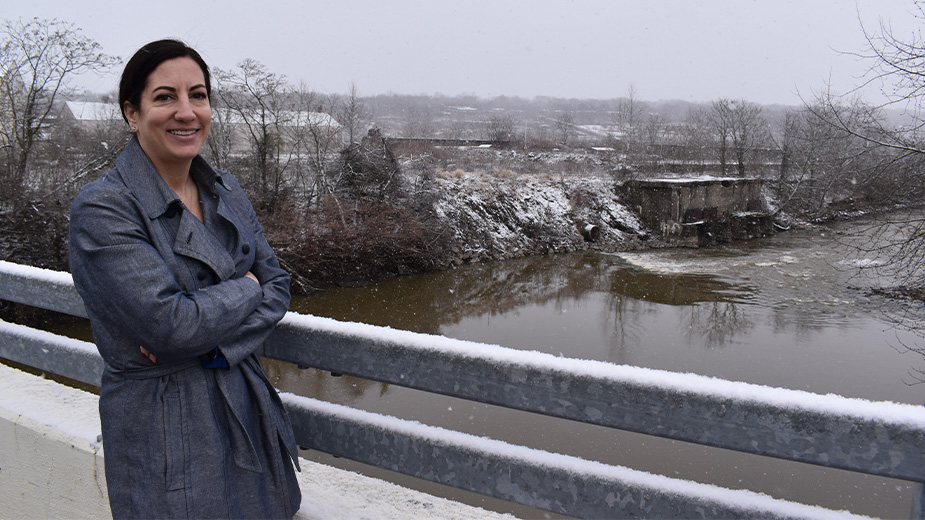Downtown Advocates Outline Plan, Next Steps
YOUNGSTOWN, Ohio — Proponents of a new downtown revitalization initiative aim to encourage a greater collective buy-in by stakeholders to keep this plan from joining the many earlier proposals gathering dust.
Copies of a memorandum of understanding are being distributed to downtown businesses and residents following Tuesday’s meeting of the Downtown Youngstown Economic Action Group. During the meeting, held at the Youngstown Business Incubator, the group presented its Downtown Vision & Action Plan.
The 150-page document, available for download here [CLICK HERE], was co-written by Dominic C. Marchionda, city-university planning coordinator in the Youngstown State University Center for Urban and Regional Studies, and Sarah Wenger, community development program manager for the Eastgate Regional Council of Governments.
Prepared over six months, the plan identifies eight initiatives with immediate, short-term, mid-term and long-term actions to be taken over the next five years. These objectives are establishing downtown as a destination, developing opportunity sites such as riverfront property along the Mahoning River, infrastructure upgrades and parking management.
The plan draws on elements of past plans as well as more recent material, including a parcel-by-parcel analysis of downtown properties that began in December 2013.
“We did not hire consultants. We did it with people from here who are going to be here for a while or plan on being here,” Marchionda said. “We expect it to change.”
Another aspect of the plan is addressing market-demand opportunities. “When it comes to site locators, they are looking for a blank envelope,” Wenger said. These site locators “don’t know how to work with” downtowns to fit the properties they represent into these spaces, a pattern that results in a lack of retail shops and service providers here, she said. Downtown advocates need to “create the dialogue, create the language so that downtown is an opportunity,” she said.
“Progress is not a linear function or process. It’s really a step-up approach, and anytime you do that, the hardest part is developing a strategy,” Marchionda added. “We have business consensus. We have stakeholder resident consensus. And now it’s sharing that vision and getting groups together to figure out how they can align their resources and capacity, organizationally or individually, to come together and knock off the initiatives that we’ve all set forth as a group.”
The memorandum of understanding lists specific goals. “The MOU is for us to identify everybody that wants to participate so we know who we need to be communicating with more regularly on different fronts,” Marchionda said. “We want to target more and keep the anchor participants coming back.”
The premise is not to “force anything on anybody” but persuade individuals to “take ownership of whatever initiatives align with their capacity or organizational missions, or individual interests, and come together and figure out how to get it done,” he added.
The overview followed a presentation by students from Holy Family School in Poland of a project that offered their own vision of Youngstown’s future. . The project, prepared for a competition to encourage students’ interest in engineering, addressed how to feed people in the cities of the future.
The presentation, accompanied by a tabletop model, featured Youngstown in the year 2172, with hydroponically grown food in a geodesic dome and a large factory for Big Cricket Farms, which breeds crickets for use as components of food. Other features included a “Hyperloop” for transportation and a restored Idora Park.
“Once you realize that the rules in this world were created by nobody really smarter than you, you can change things, you can do what you want to do, what your vision is,” Marchionda advised the students.
The plan the Downtown Youngstown Economic Action Group presented Tuesday is “a model for how to do this stuff,” Hunter Morrison, a northeastern Ohio urban planner, told those at the meeting. “This is extraordinary. It’s not happening anywhere else in northeast Ohio at this scale, with this energy,” he remarked.
“The word plan is a verb as well as a noun,” Morrison advised. If used as a noun, it can be an “object that just sits there.” Seen as a verb, it’s a “human activity,” he said. “So keep going with the verb.”
“For those of us who have been working on revitalization projects downtown for many years, this was a breath of fresh air,” said Scott Schulick, vice president of Youngstown CityScape’s board of directors, following the meeting.
“The key is that we as stakeholders come together and do our respective parts. The key to this project is that no one owns it,” he said. “We collectively as downtown stakeholders own it.”
Near-term projects include upcoming enhancements to Wick Avenue and Commerce Street, which connects to Phelps Street, “and Phelps connects from the core of the university all the way to the newly vacated riverfront, and that’s ripe for development,” Marchionda said. The city recently put out a request for proposals for an amphitheater and greenspace in that area that could tie into other potential developments.
“That’s the kind of stackable stuff that we want to talk about,” he said. “We can leverage all of those little initiatives into some of the bigger ones and go after some bigger funding to see it all happen.”
Copyright 2024 The Business Journal, Youngstown, Ohio.



